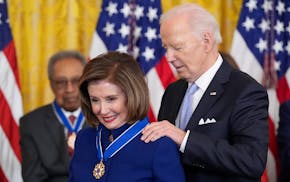When Bob Crabb got his first look at the prototype of an electronic book reader 14 years ago, he would have bet his house that by now the bookstores he manages at the University of Minnesota would have gotten rid of most printed books.
Instead, he thought, they'd be selling PIN codes that could be used to access the publications electronically.
Fortunately for Crabb, he couldn't find anyone willing to take that bet. He still has his house, and his stores still have their books.
"I'm surprised by that," he admitted. "I thought that this generation of students, who grew up using electronic devices from the time they were in grade school, would have embraced this technology."
They certainly have in other areas. They communicate electronically, they shop electronically, they navigate electronically, many of them even manage their love lives electronically. But not all are reading their textbooks electronically.
Count U of M freshman Elin Mixer among them.
"I like textbooks," she said as she sat a table at the U's Coffman Union, a book open in front of her as she traded off between a highlighter and a pen she was using to jot notes in the margins.
"I don't like reading online; I think it's harder to follow," she explained. "I like to highlight things. I like to flip back and forth [between pages] if I need to. And I like to make notes. In fact, if I have to research something online, I always print it off so I can read it on paper."
U of M junior Sarah Crumrine sat in an overstuffed chair with a textbook plopped in her lap in another part of the student union.
"I like to have what I'm studying right in front of me," she said. "Having it on paper forces my attention. If I start looking at stuff online, I get distracted and end up on Facebook."
Keeping a distance from online distractions could be another reason that, at most, e-books account for about 4 percent of sales in college bookstores, and that's on campuses that are actively promoting them. Other colleges report that digital books make up as little as 1 percent of their sales.
About 10 percent of the casual reading market -- which has many more titles available -- involves e-books. And proponents argue that once more textbooks are transferred to the medium, sales will pick up.
But limited availability alone doesn't account for the tepid interest. In a recent study by the National Association of College Stores, 74 percent of college students said that, given a choice between an e-book and the traditional printed version of the same thing, they'd go old school.
They feel that way even though standard textbooks cost about twice as much as their digital counterparts, and the weight comparisons are off the charts. Keep in mind that most of the students already are toting around laptop computers on which they could download many of the e-texts, so the weight of the physical books in their backpacks is pure extra ballast.
E-books pose challenges
But e-books come with their own baggage, said Dan Bergeson, director of Carleton College's auxiliary services, including its bookstore, which is on the low end of the e-book sales spectrum.
"There are issues with standardization, both of content and format," he said. "And with a lot of these books, you're only gaining access to them for three months. It's not like a textbook that you can sell back to the bookstore or sell to a friend."
While an e-book is cheaper than a printed version initially, the ability to sell the book when the student is finished with it offsets most of those savings, Crabb said. And for students who print lots of pages from their e-books, "they're actually losing money by the time you factor in the [printer] toner."
Even the versions that can be downloaded and saved scare off some students, especially when it involves books in their major that they hope to keep for years. Having grown up in the e-age, they've seen how quickly formats can be discarded. Allegorically speaking, they don't want to end up with a pile of Beta videotapes in a DVR world.
And don't overlook the power issue. "Books don't need batteries," Bergeson said. Batteries on laptop computers and digital book readers run out, and coffeeshops and student unions have only so many electrical outlets.
'What they're used to'
But the biggest reason behind the slow acceptance of e-books is tradition. "The students grew up using printed books," Crabb said. "It's what they're used to."
The manufacturers of digital reading devices are scurrying to address the students' issues, particularly their desire to mark up the books.
"There are devices that allow you to highlight in multiple colors and make notes to yourself, but it's still a bit awkward," he said.
Besides, ultimately it's not the students that the manufacturers need to appease.
"Professors drive the sale of books," Bergeson said. "The manufacturers need to get the professors to sign on to urge their students toward e-books. But it's not happening because if you use an e-book, then everyone has to bring a computer or a reader to class, and a lot of professors think that there already are enough electronic devices being used in their classrooms."
Jeff Strickler • 612-673-7392

Helen Simonson is in Jane Austen mode with 'The Hazelbourne Ladies Motorcycle and Flying Club'
New Orleans' own PJ Morton returns home to Jazz Fest with new music

Biden awards the Medal of Freedom to Nancy Pelosi, Medgar Evers, Michelle Yeoh and 15 others
![Mia's former associate curator of Native American Art Jill Ahlberg Yohe.
] ELIZABETH FLORES • liz.flores@startribune.com](https://arc.stimg.co/startribunemedia/KLM6KWE7YJDQRICKFBZ3QEYRPA.jpg?h=91&w=145&fit=crop&bg=999&crop=faces)
